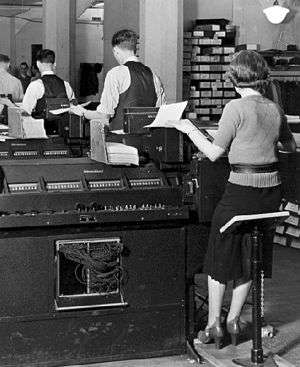Social machine

A social machine is an environment comprising humans and technology interacting and producing outputs or action which would not be possible without both parties present.
Concept
Social machines blur the lines between computational processes and input from humans.[1] They often take the form of collaborative online projects which produce web content, such as Wikipedia,[2] citizen science projects like Galaxy Zoo, and even social networking site such as Twitter have also been defined as social machines.[3] However, a social machine does not necessarily produce outcomes which directly affect the individuals or machines involved and an alternative viewpoint states that Social Machines are "rather than being an intentionally engineered piece of software - the substrate of accumulated human cross-system information sharing activities".[4][5]
An academic field investigating the idea has been active since Tim Berners-Lee's book Weaving the web. Social machines are characterised as 'social systems on the Web ... computational entities governed by both computational and social processes'.[6]
Real life is and must be full of all kinds of social constraint – the very processes from which society arises. Computers can help if we use them to create abstract social machines on the Web: processes in which the people do the creative work and the machine does the administration. The stage is set for an evolutionary growth of new social engines.[7]
See also
- Crowdsourcing
- Internet of things
- Social computing
- Social software
- Social technology
- Human-based computation
- Augmented intelligence
References
- ↑ Shadbolt, Nigel R.; Daniel A. Smith; Elena Simperl; Max Van Kleek; Yang Yang; Wendy Hall (2013). "Towards a Classification Framework for Social Machines" (PDF). WWW 2013 Companion. Retrieved 25 May 2014.
- ↑ Berners-Lee, Tim; J. Hendler (2009). "From the Semantic Web to social machines: A research challenge for AI on the World WideWeb" (PDF). Artificial Intelligence. doi:10.1016/j.artint.2009.11.010. Retrieved 25 May 2014.
- ↑ Meira, S.R.L.; Buregio, V.A.A.; Nascimento, L.M.; Figueiredo, E. "The Emerging Web of Social Machines". Computer Software and Applications Conference (COMPSAC), 2011 IEEE 35th Annual. 0730-3157. doi:10.1109/COMPSAC.2011.12. ISSN 0730-3157.
- ↑ Luczak-Roesch, M.; Tinati, R.; O'Hara, K.; Shadbolt, N. "Socio-technical Computation". CSCW'15 Companion Proceedings of the 18th ACM Conference Companion on Computer Supported Cooperative Work & Social Computing. ACM. doi:10.1145/2685553.2698991.
- ↑ Luczak-Roesch, M.; Tinati, R.; Shadbolt, N. "When Resources Collide: Towards a Theory of Coincidence in Information Spaces". WWW 2015 Companion. ACM. doi:10.1145/2740908.2743973.
- ↑ "About". SOCIAM. Retrieved 25 May 2014.
- ↑ Berners-Lee, Tim; Mark Fischetti (1999). Weaving the Web: The Original Design and Ultimate Destiny of the World Wide Web by its inventor. Britain: Orion Business. ISBN 0-7528-2090-7.
Further reading
- Anatol W. Holt (1997), Organized Activity and its Support by Computer, Springer, ISBN 978-0792347088
- Wade Roush (1 Aug 2005), "Social Machines", MIT Technology Review
- Peter Semmelhack (2013), Social Machines: How to Develop Connected Products That Change Customers' Lives, John Wiley & Sons, ISBN 978-1118637296
- Ursula Martin, Alison Pease (2013), "Mathematical Practice, Crowdsourcing, and Social Machines", Intelligent Computer Mathematics, pp. 98–119, ISBN 978-3-642-39319-8
- Donath, Judith (2014), The Social Machine: Designs for Living Online, MIT Press, ISBN 9780262027014
External links
- SOCIAM: The Theory and Practice of Social Machines — slide show
- Observing Social Machines Part 1: What to Observe — pre-print